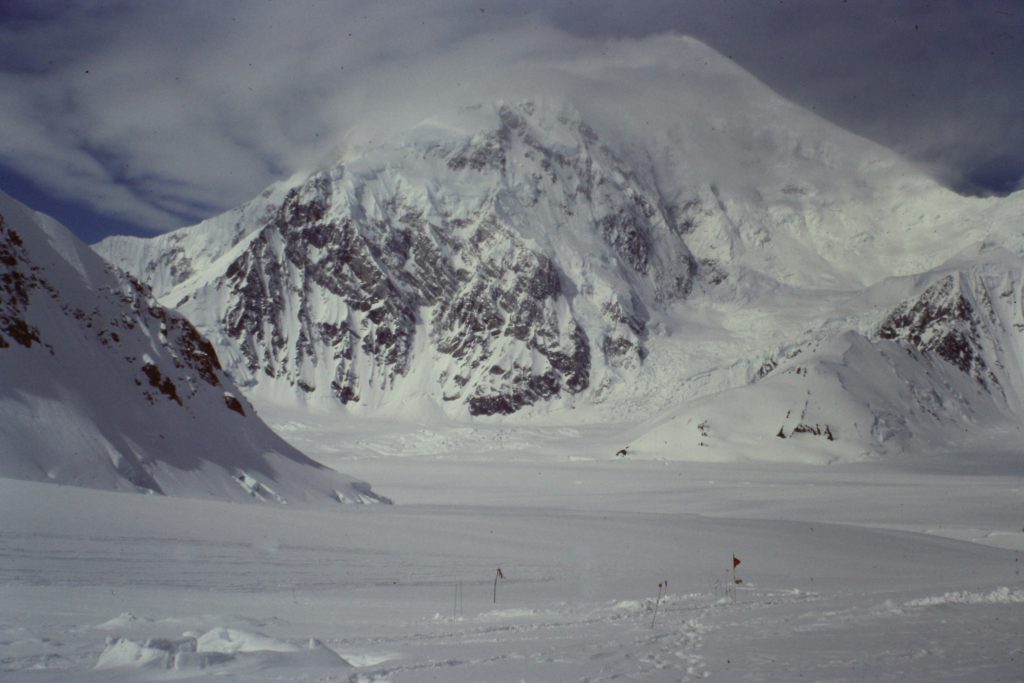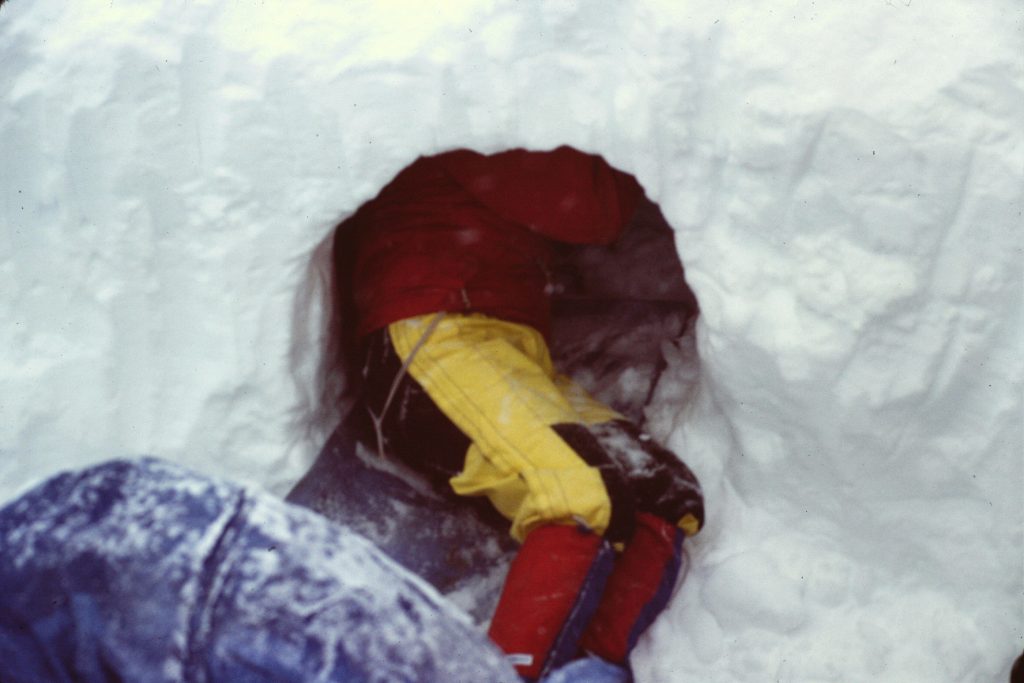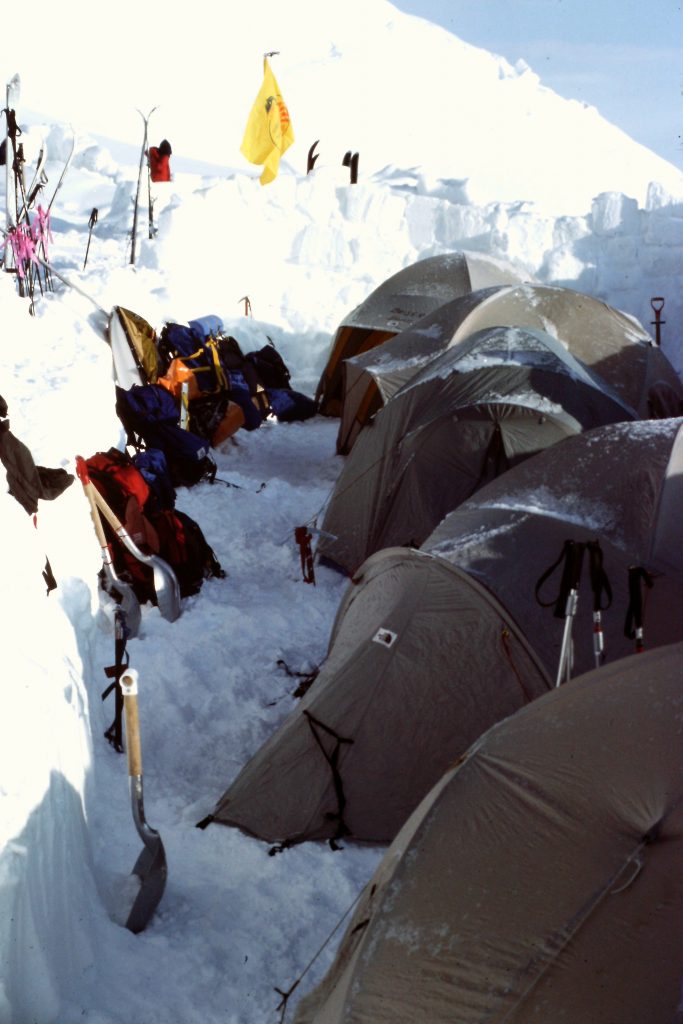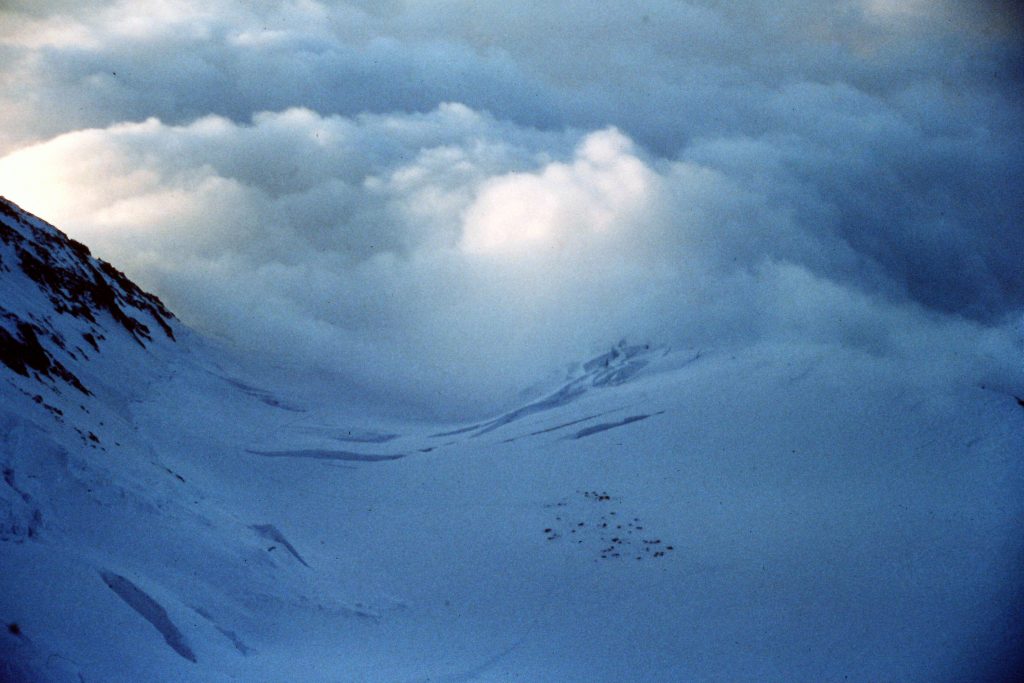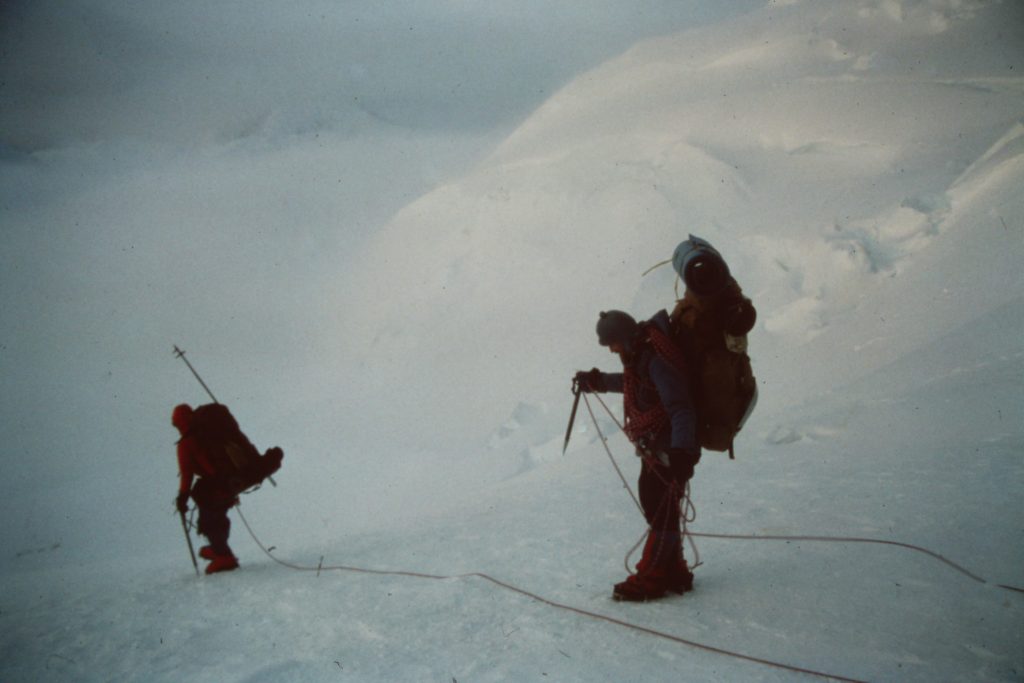Return to ARTICLES INDEX
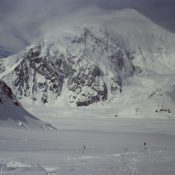
In 1987, I joined a second University of Idaho Expedition to Denali. In retrospect, the 1987 attempt was doomed from the start. I was the only climber not living in Moscow and the leader (an extremely competent climber) evidently took a hands-off approach to managing the planning aspects of the climb. Poor planning of food requirements, too many climbers on the team and several inexperienced climbers were the primary elements that doomed the attempt. The food planners mostly brought food directly off grocery store shelves like boxed spaghetti dinners and similar meals which they did not even bother to repack. The food was difficult to prepare in cold, snowy conditions and, worst of all, there was not enough of it. In my climbing log, I noted on the second day of trip that the food situation would likely keep us from reaching the summit.
Contents:
- Magazine Article Discussing the Expedition
- My Journal Entries
- Photos: I added a few photos below. For a full a photographic account of a climb use these links to my other two visits to Denali: UI 1985 Denali Expedition 1985 and Say It Ain’t So: 2009 Denali Expedition
Here is an article by Dianna Armstrong published in Idaho: The University, Vol. 5, No. 1.
May 22, 1987. Day 1. Kahiltna Base. We are on the mountain. Early this morning, the skies cleared and we flew into Kahiltna Base. By noon, the whole crew (13 climbers) had landed and our camp was assembled. Our arrival was preceded by lots of bad, stormy weather and one aborted flight on the evening of May 21st. The aborted flight turned into a bonanza for me–as I got two scenic flights for the price of one. On both occasions, the views were inspiring.
May 23, 1987. Day 2. Our trip up the mountain began today with full gear for 4 miles down the northeast fork to its junction with the main Kahiltna. Everyone did well on this mostly downhill part of the climb. We probably each had 140 pounds of equipment and gear. The team as a whole appeared to be in good shape.
Camp 2 (7,700 feet). The food situation is not good. The food we have is difficult to prepare, with long preparation times which is less than ideal for this type of climb. If we find ourselves in a storm, it will be impossible to cook dinner. The last time I camped at this spot we were snowed in for 2 days. Now on this trip it is snowing again. Could the same thing recur? It has snowed since 1:00PM and it seems to be snowing harder all the time. It is 11:00PM and the temperature is 15 degrees. I felt really good today–much better than 2 years ago. The extra running and the hills have made me tougher.
May 24, 1987. Day 3. It snowed all night and it is still snowing at 8:25AM. It is doubtful that we will move today because of the snow and lack of visibility. The wind has started to blow. Time to shovel out around the tent.
9:41PM. The storm finally broke around 4:00PM which was too late to get moving. It looks like the weather will be good tomorrow. The Alaska range is immense. The size cannot be captured by photos or maps. You must cross the vast landscape to understand the size. You must experience the climate to understand what total Winter can be like: no vegetation, no insects, only an occasional bird and snow, snow, snow.
May 25, 1987. Day 4. No entry today. We moved 6 miles up the glacier today without incident, built camp and then decided to do a carry of food and fuel farther up the glacier.
May 25-26, 1987. Days 4 and 5. Disaster averted. Yesterday could have been the end of the expedition. What started out as a simple gear shuttle to 9,200 feet turned into a struggle on the glacier. The carry went smoothly. We dug a cache, left our loads and started back. After traveling a mile or so, whiteout conditions settled in. On the way up, we had wanded our route with bamboo sticks which were interspersed with another team’s wands. The other team had descended ahead of us and pulled its wands. So, we now had to follow a route that was only partially wanded and where the snow quickly obliterated our tracks. After another couple of miles, we could no longer find any of our stakes. When we came through under good conditions, we had spotted a lot of crevasses in the area that we were now entering. Our chances of returning to camp was nil and the weather was deteriorating.
Our leader took a compass bearing and we started up again in a direction that lead to who knows where. By this time, we were all cold and the wind speed was increasing. After another mile, it was apparent we needed shelter. So we started digging a hole in the glacier, we went down about 8 feet and then dug horizontally to make a room big enough for all 13 of us. This was a big chore but it kept everyone warm and their minds off of potential consequences. It took us seven hours to dig such a big shelter (5pm to midnight). We had our sleds and packs to sit on but no sleeping gear. We only had snack food and I was hungry when we started. All in all it was a cold, miserable night that I will never for get. We kept our water from freezing and wondered when would the storm end and if it did not end soon, how long would we survive.
Today, the whiteout conditions ended and we spotted our camp in the distance. It is lucky that we all survived and no one suffered frostbite. The team as a whole had good survival instincts but the mountain is way bigger than all of us. I dragged into camp very hungry.
May 27, 1987. Day 6. Today we are camped below Kahiltna Pass at 10,100 feet. For the first time, it feels like we have made some real progress. This group is very slow. It is a good thing that we have lots of time. We have blue sky for the first time. I am enjoying the warmth it brings. It is 0 degrees tonight. From now on, we will be subjected to cold temperatures. It is too early to tell if we have a chance to reach the summit.
May 28, 1987. Day 7. 12:00 Noon: storm bound again. Based on radio communications, it appears that this storm is confined to lower elevations and it is clear above. It is snowing heavily at 10,000 feet. Hoping for a clearing in the storm.
2:15PM. No let up in the storm. The wind is picking up some. It looks as if today is a lost day. My training regimen worked. I believe that I am in better shape than anyone else except Craig, the best young climber in the group. Even though the night in the snow cave took a lot out of me, I recovered. The biggest problem remains the food or lack there of.
May 29, 1987. Day 8. 12:17AM. The storm cleared around 7:00PM yesterday and we immediately left to retrieve our food and fuel cache at 9,200 feet. We were back by 10:30PM. The ski in the low light and frigid air was spectacular. The weather has been horrendous and, since it is the norm, nights like last night take on significance.
11:08AM. We are packing and planning on taking everything up to 11,000 feet just below the first headwall. We had sun early on but it is gone now.
10:14PM. Completely settled in at our 11,000-foot camp. It took 2-1/2 hours to climb the 1,000 feet to this camp. A few of the team members had a rough time with the steepness and the fresh snow. Several climbers descending from Genet Basin told us that a 5-day storm was forecasted to arrive tomorrow. Yea!!!
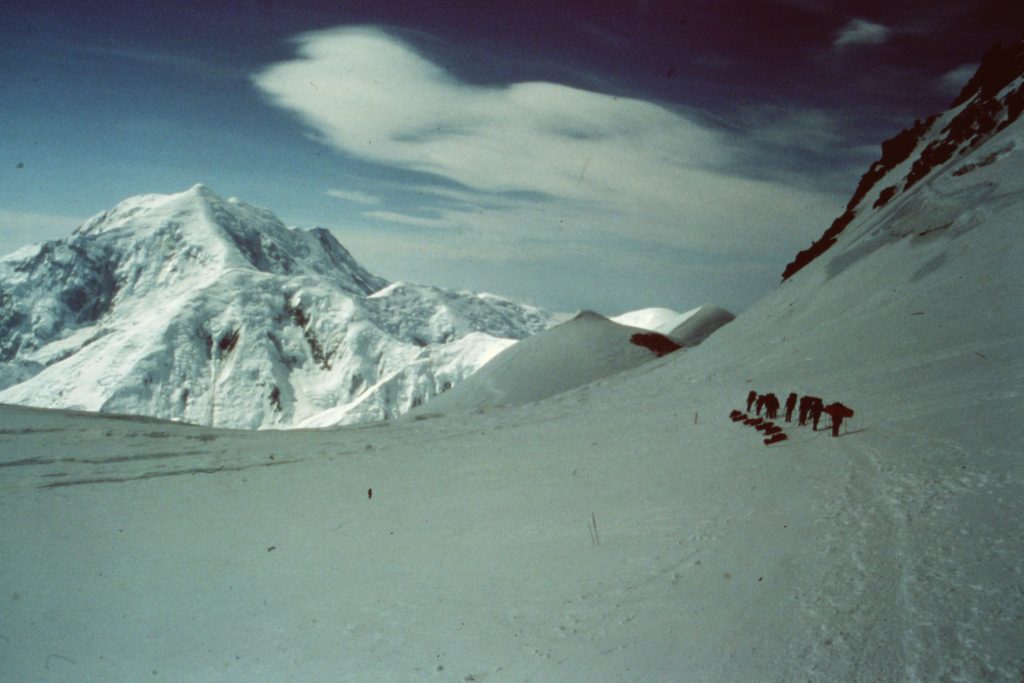
Go to Denali to experience the mountain. If you make the summit–good for you. If you do not reach the summit–still good for you.
May 30, 1987. Day 9. Today we carried food up to Windy Corner in perfect weather. Yes, we had good weather for the first time on the trip. If we have good weather tomorrow, we will reach Genet Basin and 14,300 feet. From that point, the climb will actually start and all of this necessary but time consuming trudging will be over. Conceivably, we could be on top in 3 days. Realistically, 5 days is more likely.
May 31, 1987. Day 10. We are at 14,300 feet at the base of the peak, 6 miles and 6,000 feet below the summit. I have my first headache of the trip. Dehydration or altitude? I don’t know. Tomorrow we will pick up the Windy Corner cache which will help everyone acclimatize.
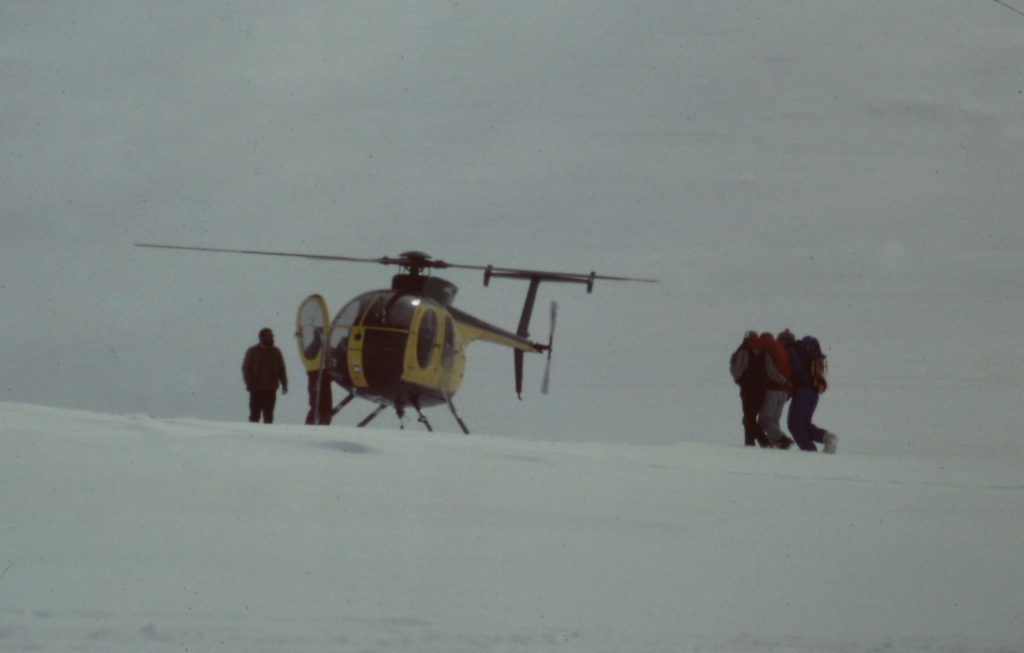
An injured climber being taken out. Almost every year someone dies on the West Buttress Route and many more are injured.
The weather was good again today. Lower down the mountain, the land is covered with clouds. I imagine it is still snowing. The views are as spectacular as I remembered them.
June 1, 1987. Day 11. Today we brought up our cache. We are now in a position to push on to the summit. We need 3 days of good weather. The weather forecast is for a high-pressure system to move in. I will believe it when I see it. Today, it snowed until 6:00PM.
June 2, 1987. Day 12. Today we carried loads up to 16,000 feet and dug a cache. A lot of people on the headwall. Weather-permitting, we will climb to 17,200 feet tomorrow. It is impossible to not reflect on being in a similar position in 1985. Will the weather stop us? Tonight, it was 0 degrees as we cooked dinner. I am still hungry. Not enough food.
June 3, 1987. Day 13. Mike called for a rest day. Not sure who talked him into it. We should not waste a day at this point. The team is too diverse and some of the slow climbers should suck it up and stay at this camp. I don’t see that happening. I feel as though I am losing the summit as I sit in camp being a good teammate.
June 4-5, 1987. Days 14 and 15. 12 of us made it to the 17,200-foot camp. One stayed down at Genet Basin keeping a tent. Thus, we are now sleeping 4 climbers to each VE-24 tent. If you think that 3 is too many for these tents (like I do), you know that 4 is way too many. Anyway, on June 4th, we successfully moved camp up to 17,200 feet. It was the best weather day of the entire trip. It should have been our summit day. On June 5th, we woke up to deteriorating weather but started out for the summit with 3 roped teams. The expedition leader was sick and stayed in camp so we had 2 ropes of 4 climbers and 1 rope of 3 climbers.
I was in charge at this point and brought up the rear. As we approached Denali Pass, the first 2 rope teams turned around. My rope team continued on to the pass. At the pass, the wind was likely exceeding 50 mph. My rope team had the 3 most experienced climbers. We started up from the pass but at around 18,400 feet, we surrendered to the wind and turned around. It was a good decision as the wind was creating ground blizzard conditions and probably blowing a lot harder 2,000 feet above the pass. The next day, I took 2 sick climbers down to the 14,300-foot camp as the weather continued to deteriorate. The rest of the team came down the next day. Out of food. We were done.
June 6, 1987. Day 16. A restless night and a bad headache. I can now report that the climb is over. The morning weather forecast convinced me to go down. I came down with 3 other climbers earlier this afternoon. 2 were sick and 1 realized he was out of his depth. 7 climbers and Mike are still at the high camp, planning on a summit attempt tomorrow? Why not today?
June 7, 1987. Day 17. We moved down to 11,000 feet after the remainder of the team surprised us and arrived in camp at noon. Weather permitting, tomorrow we will ski out to Kahiltna Base. We have only a little food left.
June 8, 1987. Day 18. Mike, Craig and I teamed up and made a bee line to Kahiltna Base. We arrived in a snow storm, famished. We quickly dug up an emergency cache and fired up a stove. Mike was so hungry that he started to eat a freeze-dried meal we found in the cache without adding water. We were resigned to spending the night when we heard a plane overhead. Looking out of the tent, we saw a break in the clouds. Let’s get the hell out of here. We packed in a flash and climbed into the plane. I’m writing this in Talkeetna, drinking a beer.


